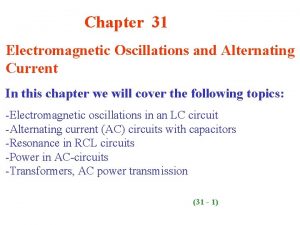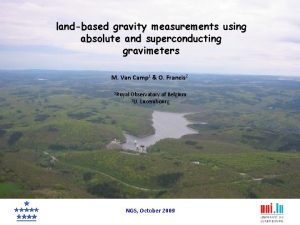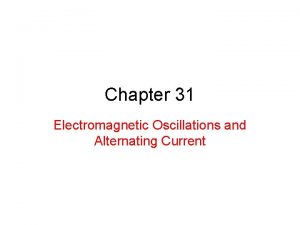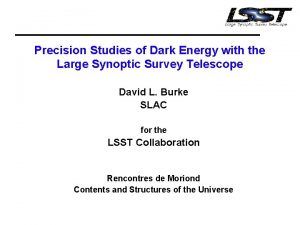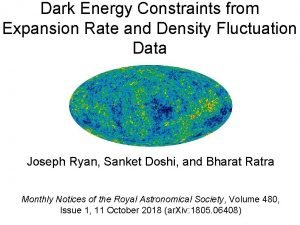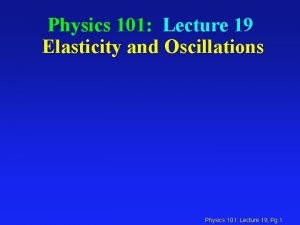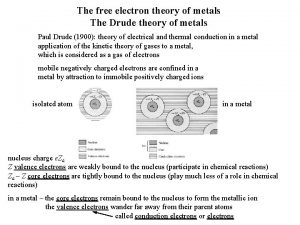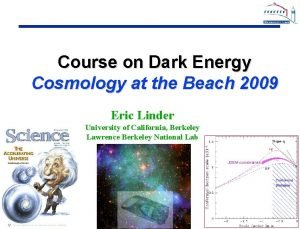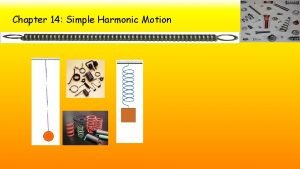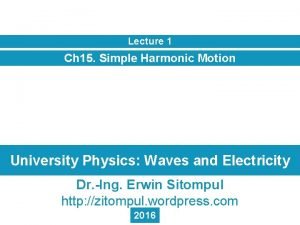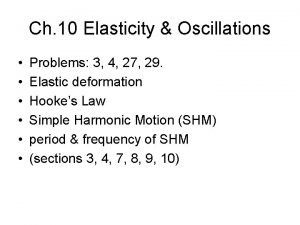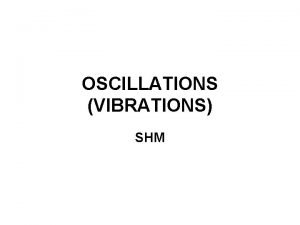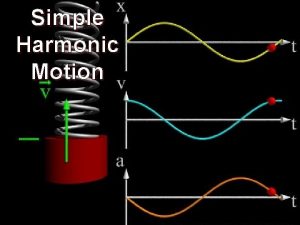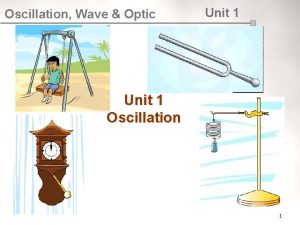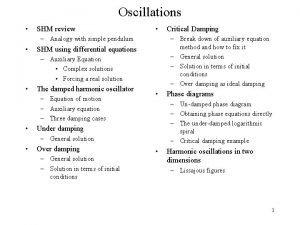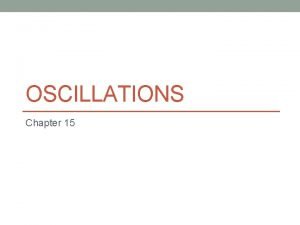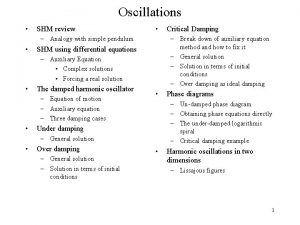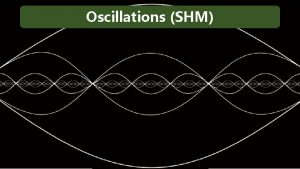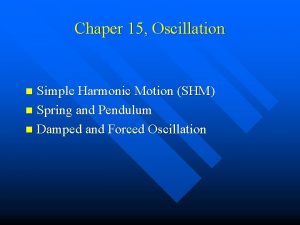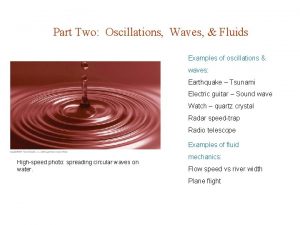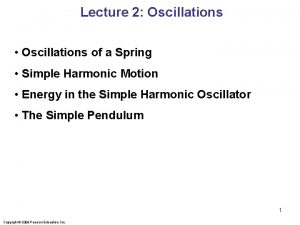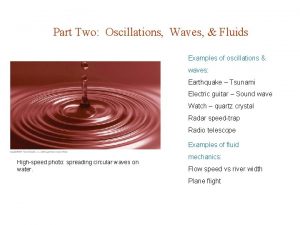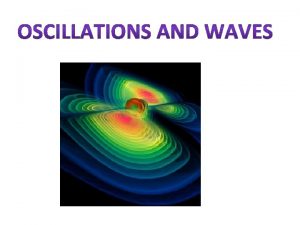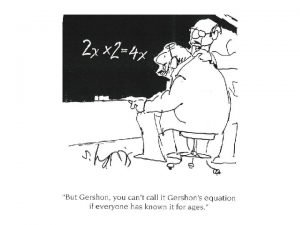Oscillations SHM Oscillations In general an oscillation is



















- Slides: 19

Oscillations - SHM

Oscillations In general an oscillation is simply aback and forth motion l Since the motion repeats itself, it is called periodic l We will look at a special type of oscillation - SHM l

Simple Harmonic Motion l SHM is a result of the restoring force varying linearly with the displacement. l In other words if you double the distance moved by the oscillator, there will be twice as much force trying to return it to its natural state

SHM l. A mass on a spring is the prime example of SHM since the force that restores it to its equilibrium position is directly proportional to the amount by which the spring is stretched.


Hook’s Law l The law that governs how spring stretches F = -kx l l l F – force exerted by the spring (N) x – the amount by which he string is stretched or compressed (m) k – spring constant. A measure of how “stiff” the spring is (N/m) A small spring has a k= 200 N/m the neg. sign indicate that displacement and force is in opposite direction

Mass Oscillating on a Spring (1) (3) (2) (4)


New formula l Since acceleration is not constant our Big 4 Equations do not work l F = ma is still ok but a is always changing l Calculating period: T does not depend on amplitude – does this make sense? l Frequency:

SHM - Example l Many skyscrapers use huge oscillating blocks of concrete to help reduce the oscillation of the building itself. In one such building the 3. 73 x 105 kg block completes one oscillation in 6. 80 s. What is the spring constant for this block?

Additional Problems l A block of mass 1. 5 kg is attached to the end of a vertical spring of force constant k=300 N/m. After the block comes to rest, it is pulled down a distance of 2. 0 cm and released. (a) What is the frequency of the resulting oscillations? (b) What are the maximum and minimum amounts of stretch of the spring during the oscillations of the block? l When a family of four people with a mass of 200 kg step into their 1200 kg car, the car's springs compress 3 cm. (a) What is the spring constant of the car's springs, assuming they act as a single spring? (b) What are the period and frequency of the car after hitting a bump? l A small insect of mass 0. 30 g is caught in a spiderweb of negligible mass. The web vibrates with a frequency of 15 Hz. (a) Estimate the value of the spring constant for the web. (b) At what frequency would you expect the web to vibrate if an insect of mass 0. 10 g were trapped?

Energy Involved with SHM l Let’s look at a similar situation but concentrate on the energy of the object l Energy stored in a spring (potential energy) l U =PE = ½ kx 2

Energy of SHM 1 3 2 4

Energy Formula l If total energy = PE + KE ½ kx 2 + ½ mv 2 l Then Total energy =PE (max) (KE = 0) = ½ kx 2 max Remember X(max) = Amplitude

Velocity l If we combine all our formulas: l Which is useful when we solve for v

Simple Pendulum l Is this motion SHM?

Pendulums l Weight is broken into components l l Y component = tension of rope X component = restoring force ( brings the pendulum back resting position) l l F = -mg(sinθ) (neg. because it acts opp to displacement) If the angle is small and measured in radians the sin of angle basically equals the angle itself (only if θ < 15°) l Therefore F=-mgθ

l Now the arc length “x” is given by l l X=Lθ Which means that we can replace the angle In the force formula with x/L l l F = -mg (x/L) F = (mg/L)x The formulas is just F = -kx with the mg/L taking the place of k l Therefore we do have SHM l

Period of a Pendulum l Period of a Spring l Replace the k with mg/L l Period of a pendulum l
 Angular oscillation
Angular oscillation Tanya leise amherst
Tanya leise amherst Sustained translatory technique
Sustained translatory technique Oscillations
Oscillations Plasma oscillations
Plasma oscillations Electromagnetic oscillations and alternating current
Electromagnetic oscillations and alternating current Slow oscillations
Slow oscillations Baryon acoustic oscillations
Baryon acoustic oscillations Electromagnetic oscillations and alternating current
Electromagnetic oscillations and alternating current Baryon acoustic oscillations
Baryon acoustic oscillations Coupled pendulum
Coupled pendulum Baryon acoustic oscillations
Baryon acoustic oscillations Baryonic acoustic oscillations
Baryonic acoustic oscillations Elasticity and oscillations
Elasticity and oscillations Free electron model of metals
Free electron model of metals Baryon acoustic oscillations
Baryon acoustic oscillations The cone of a loudspeaker vibrates in shm
The cone of a loudspeaker vibrates in shm Shm
Shm What is angular frequency in shm
What is angular frequency in shm Frequency in simple harmonic motion
Frequency in simple harmonic motion





